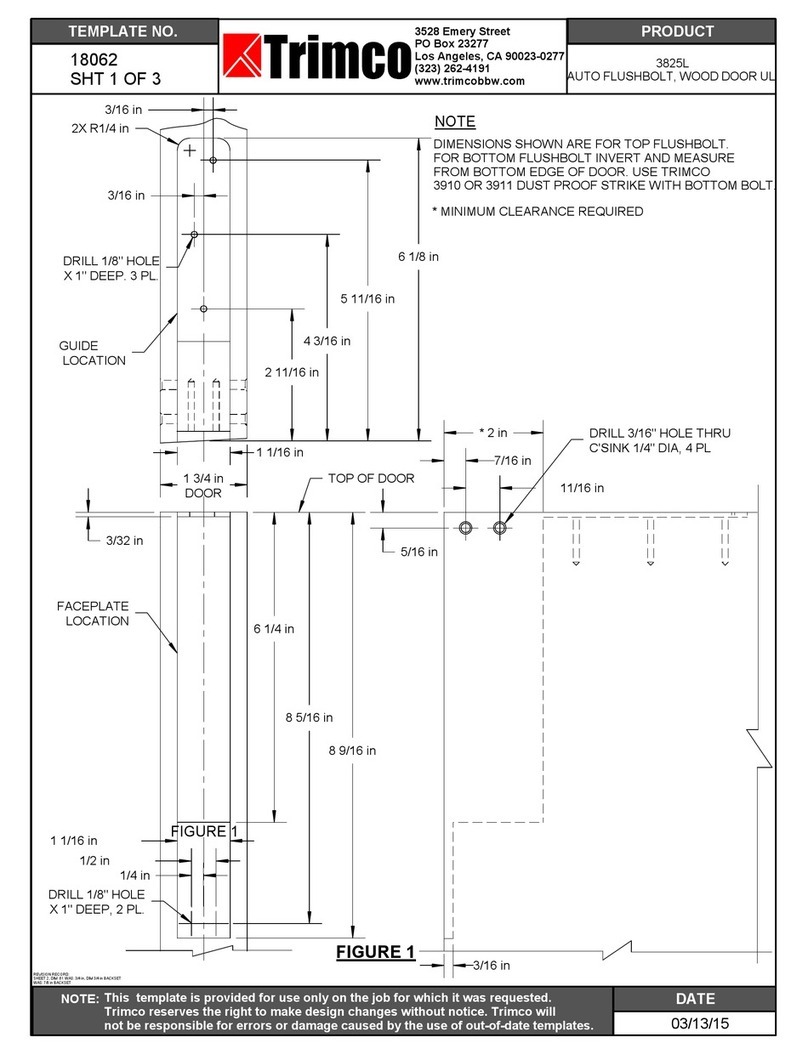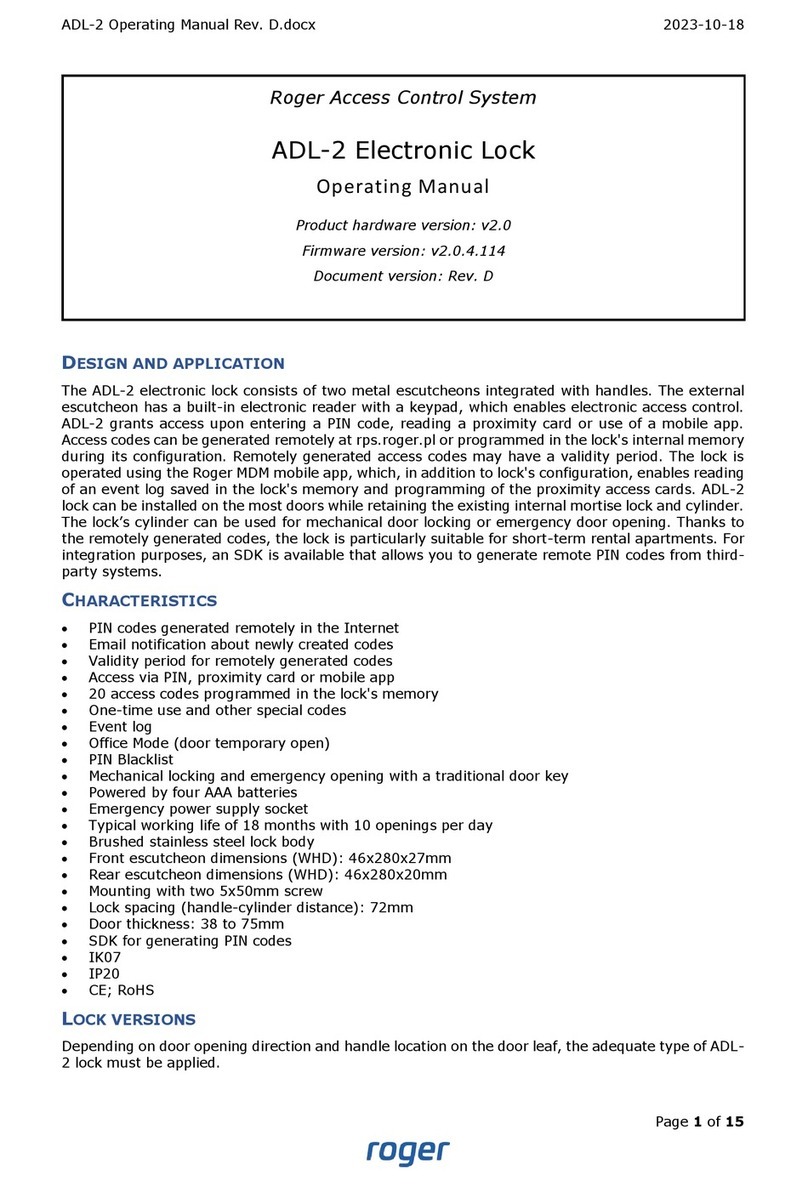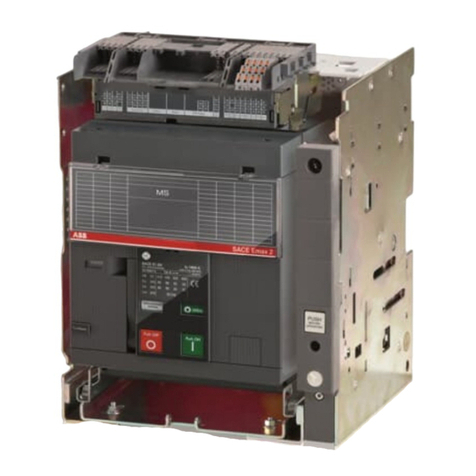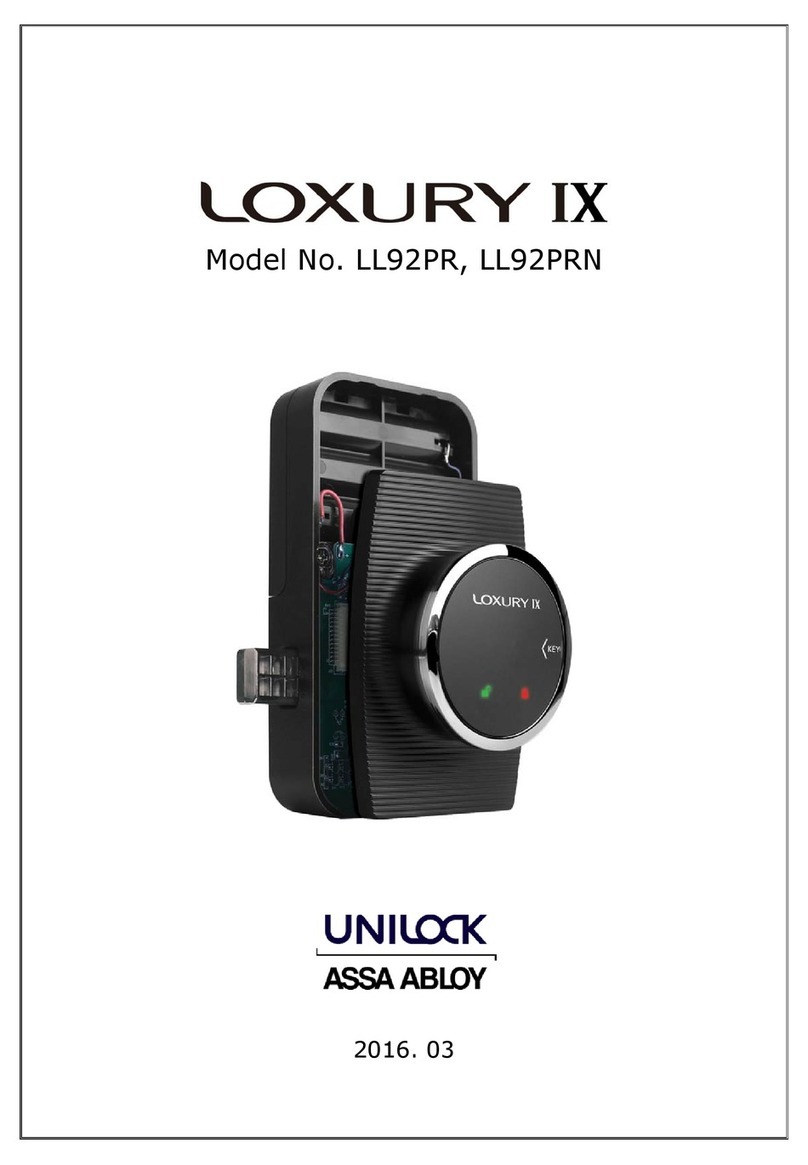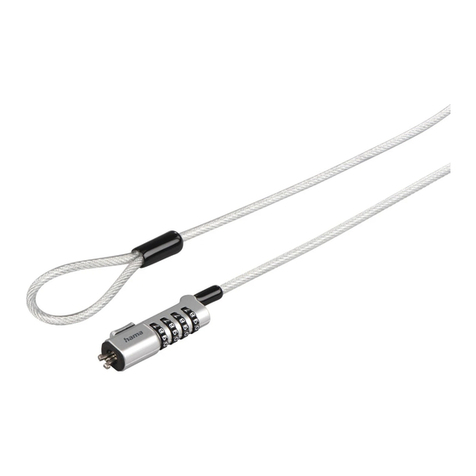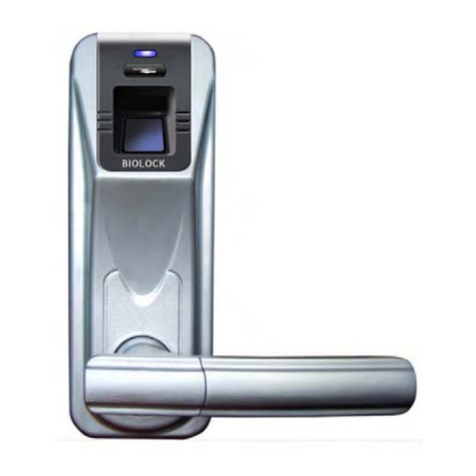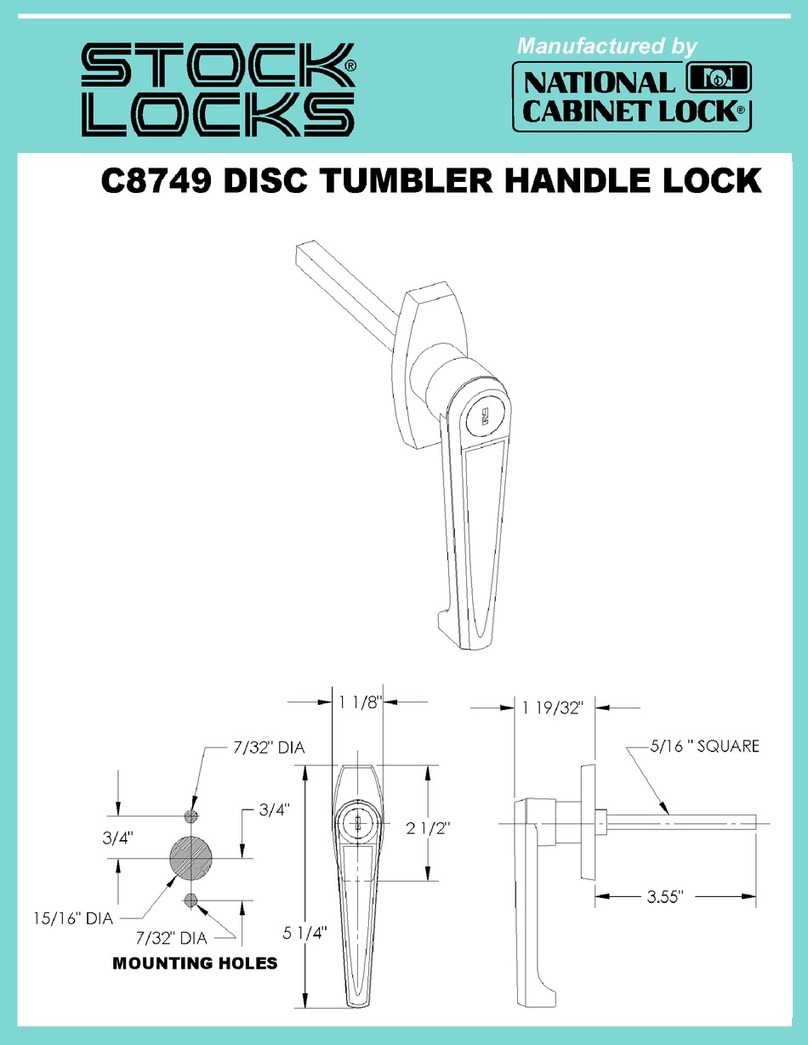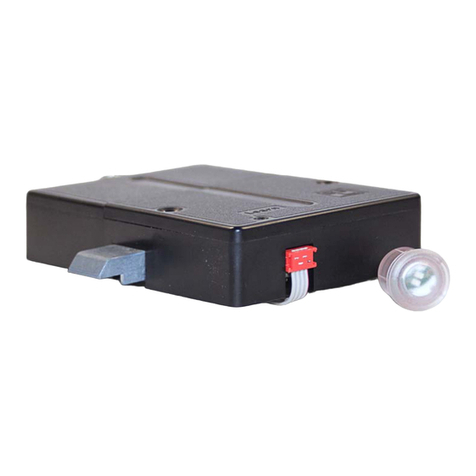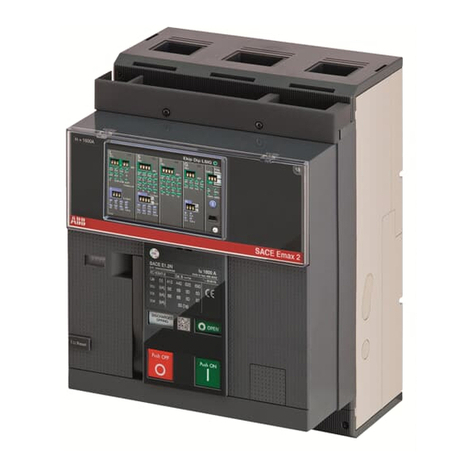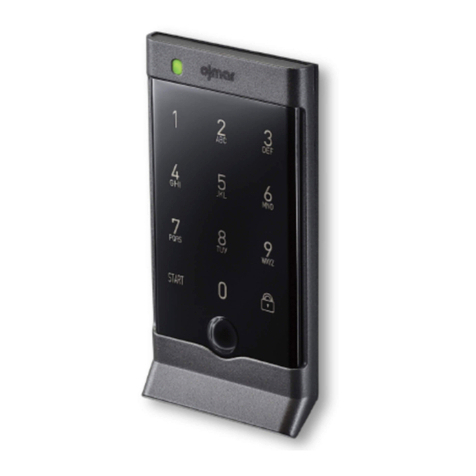Ava bqt YD30M COBALT-mini User manual

INSTALLATION AND OPERATING INSTRUCTIONS
Sideload Lock YD30M COBALT-mini V1.5

Page 2
NOTICES
Please ensure you read all instructions!
WARNING - Live parts inside.
WARNING - The handling and installation of this device is recommended for a professional.
WARNING - Use of an unsuitable power supply unit may cause product failure or injury.
WARNING - Do not remove the cover or face plate.
WARNING - Ensure installation does not expose sharp edges of the product to users.
This device complies with Part 15 of the FCC Rules. Operation is subject to the following two conditions:
1. This device may not cause harmful interference.
2. This device must accept any interference received, including interference that may cause undesired
operation.
Note: This equipment has been tested and found to comply with the limits for a Class B digital device,
pursuant to Part 15 of the FCC Rules. These limits are designed to provide reasonable protection against
harmful interference when the equipment is operated in a residential, commercial, or industrial
environment. This equipment generates, uses, and can radiate radio frequency energy and, if not
installed and used in accordance with the instruction manual, may cause harmful interference to radio
communications. However, there is no guarantee that interference will not occur in a particular
installation.
Modifications: Any modifications made to this device that are not approved by the manufacturer may
void the authority granted to the user by the FCC to operate this equipment.
BQT Solutions (SEA) Pte. Limited, 41B Neil Road, #03-01, Singapore, 088824
EN 14846:2008
Notified Body 0905
Reference Number DoPYD30
Suitable for use on fire and/or smoke control doors
Characteristics
3
Y
9
F
0
0
0
1
1/3*
Declaration of Performance and Declaration of Conformity are available at www.bqtsolutions.com
19
*The product meets the requirements of class 3 for position 9 “Security – Electrical Manipulation” when set to “Fail Secure” mode, and only meets the requirements for class 1 when set to “Fail Safe” mode.
In the European Union, Norway, Iceland and Liechtenstein: This symbol on the product, or in the
manual and in the warranty, and/or on its packaging indicates that this product shall not be treated as
household waste. Instead it should be taken to an applicable collection point for the recycling of electrical
and electronic equipment.
By ensuring this product is disposed of correctly, you will help to prevent potential negativeconsequences
to the environment and human health, which could otherwise be caused by inappropriate handling of this
product.
In Countries Outside the European Union, Norway, Iceland and Liechtenstein: If you wish to dispose
of this product please contact your local authorities and ask for the correct way of disposal.
© 2019 BQT Solutions (SEA) Pte Limited. All rights reserved.
“Cobalt-mini”is a trademark of BQT Solutions (SEA) Pte. Limited.
BQT Solutions (SEA) Pte Limited products and processes may be covered by intellectual property rights,
including but not limited to copyright protection, trademark protection, and pending patent protection. Such
pending patent protection may at least be by patent application originating from the published international
application WO2013/168114.
BQT Solutions (SEA) Pte Limited will not be liable for any direct, indirect, incidental or consequential loss or
damage in any way related to this product. BQT Solutions (SEA) Pte Limited reserves the right to upgrade or
change this product or instruction manual without prior notice. BQT Solutions (SEA) Pte Limited assumes no
liability for damages incurred directly or indirectly from errors, omissions or discrepancies between theproduct
and the manual.
The Cobalt-mini is designed by BQT Solutions (SEA) Pte. Limited and manufactured by BQT Solutions (NZ)
Limited in New Zealand.
For more information and contact details please visit,
www.bqtsolutions.com

Page 3
CONTENTS
1. DESCRIPTION.........................................................................................................................................................4
2. PRODUCT UNBOXED ............................................................................................................................................4
3. DIMENSIONS ..........................................................................................................................................................5
3.1. LOCK...................................................................................................................................................................5
3.2. STRIKE PLATE .....................................................................................................................................................5
3.3. FITTING TAB ........................................................................................................................................................5
3.4. HOUSING.............................................................................................................................................................5
3.5. DRESS PLATE......................................................................................................................................................5
4. PRE-INSTALLATION ASSESSMENT....................................................................................................................6
4.1. MECHANICAL .......................................................................................................................................................6
4.2. ELECTRICAL.........................................................................................................................................................6
5. INSTALLATION.......................................................................................................................................................7
5.1. MORTISE INSTALLATION .......................................................................................................................................7
5.2. SURFACE INSTALLATION.......................................................................................................................................8
6. WIRING..................................................................................................................................................................10
6.1. FAIL SAFE CONNECTION.....................................................................................................................................10
6.2. FAIL SECURE CONNECTION................................................................................................................................10
6.3. JUMPER POSITION..............................................................................................................................................11
7. OPERATION..........................................................................................................................................................11
7.1. FAIL SAFE OPERATION.......................................................................................................................................11
7.2. FAIL SECURE OPERATION...................................................................................................................................11
8. SPECIFICATIONS.................................................................................................................................................12
9. MAINTENANCE AND INSPECTION.....................................................................................................................12

Page 4
1. DESCRIPTION
The Cobalt-mini is a motor driven low voltage electric lock designed to secure commercial and residential doors. It
is supplied with a matching strike plate and due to its small size it is perfect for installing into a mortise for a concealed
solution. The Cobalt-mini offers two unique features not commonly found in this style of lock;
1. The ability to ‘pull’ a door in tight against a seal.
2. The ability to release when requested even if there is excessive load on the door.
The bolt pin of the Cobalt-mini operates on a cam action which enables the bolt pin to pull a door into place. In
practice as the door closes it may come to rest in a position that is not fully closed, especially if it closing against a
door seal of some type. The Cobalt-mini senses when the door is within 8mm of being fully closed and activates the
bolt pin. The bolt pin then rotates out and pulls the door from its resting position to the closed and sealed position.
With the door secured and locked the Cobalt-mini can be given an unlock signal and it will instantly unlock. If the
door is loaded (pre-load) when the unlock signal is given the Cobalt-mini will still unlock, even with loads in excess
of 100Kg on the door. Critically the ability of the Cobalt-mini to instantly release with excessive pre-load on the door
even occurs in the event of a power failure if the lock is configured as fail safe.
Additional features of the Cobalt-mini are;
Multi-voltage input (12-24VDC)
Very low current consumption
Door position and Bolt position monitors
High physical strength –10,000N holding force
Fail safe / fail secure on site conversion with the re-positioning of a single jumper
2. PRODUCT UNBOXED
Along with the Cobalt-mini and matching strike there are also four 10G
Self Tapping Screws and eight M5 Machine Screws supplied. Four
fitting tabs are also enclosed and can be used in conjunction with the
M5 screws for recessing the lock or strike plate to metal doors and
frames.
The 7-way wire loom supplied is used to ease installation as the wiring
can be done without the lock being installed until the very end.
Wire Loom
Mounting Screws Fitting Tabs Strike Plate Lock

Page 5
3. DIMENSIONS
The dimensions shown (in millimetres) are approximate and are subject to change without prior notice.
3.1. Lock
3.2. Strike Plate
3.3. Fitting Tab
3.4. Housing
Available separately
3.5. Dress Plate
Available separately

Page 6
4. PRE-INSTALLATION ASSESSMENT
Care should be taken to refer to Section 9 - Maintenance and Inspection before proceeding with the installation.
4.1. Mechanical
The Cobalt-mini is designed for mortise installations as this offers a discrete solution as the lock and strike plate can
be embedded into the door and frame. In some instances however mortise installation is not possible so by utilizing
the YD30M housing, surface installation of the Cobalt-mini is possible. Whichever installation method is chosen it is
important that the lock and strike plate are aligned correctly. The strike plate has an opening to accept the bolt pin
and centring this opening with the bolt pin will ensure correct operation.
The Cobalt-mini can be installed vertically or horizontally but is not designed to be mounted in a floor cavity
firing upwards or in a wet environment.
When installing the Cobalt-mini vertically, take note of which way the door is closing from. It the door is approaching
form the left the bolt pin is at the top, if the door is approaching from the right then the bolt pin is at the bottom, as
indicated below:
4.2. Electrical
The first consideration is to establish where to run the wires and decide on what feedback is required from the lock.
There are a total of seven available connections; three are compulsory power connections whilst the remaining four
provide optional door and bolt position feedback. These optional connections can be integrated into access control
or alarm systems to provide full monitoring.
The correct gauge of wire needs to be chosen as voltage drop across the power wires (+ and -) can limit the locks
operation. For all the remaining connections, a lower gauge wire can be used as these are only signal wires. The
following chart shows the maximum distance that the power supply can be away from the lock, assuming the power
supplies output 12VDC or 24VDC:
AWG
AREA (MM2)
MAXIMUM DISTANCE (M)
12VDC
24VDC
24
0.20
10
30
22
0.33
16
48
20
0.52
26
77
18
0.82
41
122
16
1.31
65
195
14
2.08
103
310
Door closing
from the right,
the lock is
installed with
the bolt pin at
the bottom.
Door closing
from the left,
the lock is
installed with
the bolt pin at
the top.

Page 7
5. INSTALLATION
Two installation examples are detailed on the following pages; mortise and surface, however any combination of the
two can be achieved. Whichever installation method is chosen it is vital to ensure that the lock face plate and the
strike plate align correctly and the gap between the lock face plate and strike plate does not exceed 7mm
when the door is closed.
5.1. Mortise Installation
A typical mortise installation is described with the lock fitted into the door frame and the strike plate secured into the
door. It is possible to install the lock into the door and the strike plate into the frame however with this method running
wiring to the lock requires additional work.
5.1.1. Cutting the mortises
Referring to the dimension drawings in Section 3 -
Dimensions; mortises are cut into the door and door
frame suitable to fit the strike plate and lock.
Wooden doors and frames require full mortises
where metal doors and frames, being hollow, often
only require a single rectangle cut-out to
accommodate the lock face plate or strike plate. For
these installations the supplied fitting tabs can be
used to secure the lock and strike plate in place.
The mortise behind the lock body needs to have
enough space to accommodate the wiring.
5.1.2. Wiring the lock
Wires are run from the power supply to the lock. A
hole needs to be drilled in the back of the mortise to
bring the wires out and a connection can be made
to the supplied wire loom which in turn plugs into
the lock. The jumper needs to be positioned for fail
safe / fail secure configuration as per the
instructions on the lock cover.
The Red, Black and Blue wires are essential
connections whilst the Violet and White are
optional. Detailed wiring instructions are found in
Section 6 - Wiring.
5.1.3. Fitting the lock and strike plate
The lock is slid back into the mortise, making sure
that the wiring integrity is maintained and secure in
place with the supplied 10G self-tapping screws.
Before the strike plate is installed the fitting tabs are
secured in behind the cut-out using the supplied M5
machine screws. The strike plate is then placed into
the cut out and the remaining M5 screws are used
to secure it.
Strike plate
installed in
the door using
the fitting tabs.
Lock secured
directly into
the door frame.
Cut-out in a
wooden door
frame to
accommodate
the lock.
Cut-out in a
metal door to
accommodate
the strike plate.

Page 8
5.1.4. Checking the operation
With the lock and strike installed and wiring
complete the door is closed to check the alignment
and operation. The key area for alignment is the bolt
pin; the pin is designed to touch the leading edge of
the strike plate hole to pull the door in, but it cannot
be allowed to touch the sides of the hole as this will
limit its unlocking ability. If its rubs or touches the
side of the strike plate hole, either the lock or strike
plate needs to be re-positioned.
5.2. Surface Installation
By using a YD30M housing, the lock and or strike plate can be surface mounted to the door or door frame eliminating
the need for cutting mortises. Housings are available with adhesive tape supplied for easy application to glass doors
in addition to having screw hole mounting points for wood and metal doors.
5.2.1. Securing the lock housing to wood
Two 10G x 1” hex head self-tapping screws are
supplied with the housing and can be screwed
into the wood door frame. The housing has two
keyhole cut outs that fit over the screw heads
and once the housing is in place the screws can
be tightened with a spanner.
5.2.2. Wiring the lock
The wires will need to be run into the housing to
connect to the lock. The position of the hole is
determined at installation time by finding exactly
where the wiring will enter the housing, and drill
an 8mm hole through the housing wall. The
housing is supplied with one grommet, which
can be pushed into the drilled hole to protect the
wires from the sharp edge of the hole.
The Red, Black and Blue wires are essential
connections whilst the Violet and White are
optional. Detailed wiring instructions can be found
in Section 6 - Wiring.
Clearance
Bolt pin
Clearance
The bolt pin touches the leading edge of
the strike plate hole but there needs to be
clearance around the sides of the hole.

Page 9
5.2.3. Fitting the lock into the housing
The jumper next to the connector on the lock needs
to be positioned for fail safe or fail secure
configuration as per the directions on the lock cover.
The 7-way wire loom should be attached to the
wiring protruding from the housing and plugged into
the lock. The lock should then be slid into the
housing and secured in place with the supplied M5
machine screws. Make sure that the wiring integrity
is maintained as the lock is screwed in place.
5.2.4. Fitting the strike plate housing to glass
For simple application to glass the YD30M housing
is supplied with self-adhesive tape. With the
backing removed the housing can be applied
directly to the glass. A flat stainless steel dress plate
is fitted on the opposite side of the glass to give a
clean finish. The protective coating on the dress
plate can be removed once it is in place.
5.2.5. Fitting the strike plate into the housing
The strike plate is placed into the housing and
secured in place with the supplied M5 machine
screws.
5.2.6. Checking the operation
With the lock and strike installed and wiring
complete the door is closed to check the alignment
and operation. The key area for alignment is the bolt
pin; the pin is designed to touch the leading edge of
the strike plate hole to pull the door in, but it cannot
be allowed to touch the sides of the hole as this will
limit its unlocking ability. If its rubs or touches the
side of the strike plate hole, either the lock or strike
plate needs to be re-positioned.

Page 10
6. WIRING
The Cobalt-mini is supplied with a 7-way wire loom that plugs directly into the lock. The wires are colour coded
with the three Power wires being essential connections and four Position Switch connections optional.
Control of the lock is achieved by using the three power wires, whilst door and bolt position monitoring are available
when desired. Connect the Cobalt-mini as per the chart:
RED
Positive +
Positive connection to DC power supply
Power (12 –24V)
BLACK
Negative -
Negative connection to DC power supply
BLUE
Control
Switched positive control input
VIOLET
Bolt Position Switch
Normally open contact (NO), closed when the bolt pin is extended
VIOLET
WHITE
Door Position Switch
Normally open contact (NO), closed when the strike is aligned with the lock
WHITE
6.1. Fail Safe Connection
When wiring the Cobalt-mini, the positive voltage is connected to RED, negative is connected to BLACK and a
switched positive voltage wire connected to BLUE. In Fail Safe configuration applying voltage to the Cobalt-mini
signals it to lock. The lock signal in Fail Safe configuration is active high.
6.2. Fail Secure Connection
When wiring the Cobalt-mini, the positive voltage is connected to RED, negative is connected to BLACK and a
switched positive voltage wire connected to BLUE. In Fail Secure configuration applying voltage to the Cobalt-mini
signals it to unlock. The lock signal in Fail Secure configuration is active low.

Page 11
6.3. Jumper position
The fail mode of the Cobalt-mini is factory set as Fail Safe, i.e. in the event of a power cut the Cobalt-mini will unlock.
Before the lock is installed this can be changed to Fail Secure by repositioning the jumper located next to the 7-way
plug on the end of the lock. Select the desired jumper location as indicated:
7. OPERATION
7.1. Fail Safe Operation
Assume the lock is installed and wired, the door is open and there is voltage applied to the BLUE wire. As the door
closes the Cobalt-mini senses the door approaching and activates the bolt pin to pull the door into alignment. The
Bolt Position and Door Position monitors will have changed state as the door is moved into place and secured.
To unlock the door, voltage is removed from the BLUE wire. The Cobalt-mini will immediately release and will do so
even when significant load is being applied to the door. With the door now open the Bolt Position and Door Position
monitors change state again. The Cobalt-mini will remain unlocked as long as the door is open but will instantly re-
lock when voltage is applied to the BLUE wire and the door is closed.
In the event of a power failure, the Cobalt-mini unlocks.
7.2. Fail Secure Operation
Assume the lock is installed and wired, the door is open and voltage is removed from the BLUE wire. As the door
closes the Cobalt-mini senses the door approaching and activates the bolt pin to pull the door into alignment. The
Bolt Position and Door Position monitors will have changed state as the door is moved into place and secured.
To unlock the door, voltage is applied to the BLUE wire. The Cobalt-mini will immediately release and will do so even
when significant load is being applied to the door. With the door now open the Bolt Position and Door Position
monitors change state again. The Cobalt-mini will remain unlocked as long as the door is open but will instantly re-
lock when voltage is removed from the BLUE wire and the door is closed.
In the event of a power failure, the Cobalt-mini locks if the door is closed.
Fail Safe
= Fail Unlocked
= Power To Lock
= PTL
Fail Secure
= Fail Locked
= Power To Open
= PTO

Page 12
8. SPECIFICATIONS
MATERIALS
Bolt Pin
Stainless Steel (SS17-4PH), 10mm Thick, 13mm Extension
Lock / Strike Plate
Stainless Steel (SS304), 3mm Thick
MECHANICAL
Cycle Life
300,000 normal operations
Maximum Strike Gap
6mm
Holding Force
10,000 newtons (1,000kg)
Side Load Release
1,000 newtons (100kg)
Door Misalignment
8mm
ELECTRICAL
Voltage at Lock
12 –24VDC ±15%
Initial Power Up Time
11 seconds max, only after power has been removed for an extended period.
Current Usage
Standby Current
50mA@12V
30mA@24V
Maximum Current
1.0A@12V
0.5A@24V
Monitor Switches
Bolt Position –30VDC, 0.1A
Door Position –100VDC, 0.5A
CERTIFICATIONS
FCC
Title 47, Part 15, Subparts A & B –Class B Device
Fire Test
Fire Rated for 30 / 60 minutes
Timber / mineral composite doorsets
BS EN 1634-1:2014
BS 476-22:1987
Fire Rated for 120 / 240 minutes
Mineral E-Core doorsets
AS 1905-1:2005
BS 476-22:1987
Fire Rated for 260 minutes
Steel doorsets
EN 1634-1:2014
BS EN 1634-1:2014
CE / EU
CPR 305/2011
EN 14846:2008
3
Y
9
F
0
0
0
1
1/3*
EMC 2014/30/EU
EN 61000-6-1:2007
EN 61000-6-3:2007+A1:2011
RoHS 2011/65/EU
RoHS 2 Compliant
*The product meets the requirements of class 3 for position 9 “Security – Electrical Manipulation” when set to “Fail Secure” mode, and only meets the requirements for class 1 when set to “Fail Safe” mode.
9. MAINTENANCE AND INSPECTION
The Cobalt-mini has been lubricated at assembly and applying any other type of lubricant may void the warranty. A
dry cloth can be used to polish the stainless steel face plate and strike plate as required. This lock contains
components that are subject to wear based on usage, doorway operation and installation; all such factors are beyond
the control and measurement of the manufacturer. The lock may be vulnerable and subject to failure as a
consequence of wear and as its components near the end of the period of normal usage.
It is the responsibility of the owner/end-user to:
a) Ensure that the lock is installed in accordance with the instructions set out in these guidelines.
b) Determine the suitability of this lock for the application intended and in particular when using this lock in
critical applications such as on fire, high security, safety, or emergency exit doors.
c) Regularly inspect this lock in order to assess signs of wear and tear, and determine if the operation still
conforms to the instructions set out in these guidelines.
d) Regularly inspect the lock and evaluate cycle life.
e) Determine when this lock should be replaced.
MP001408.003
Table of contents
Popular Lock manuals by other brands
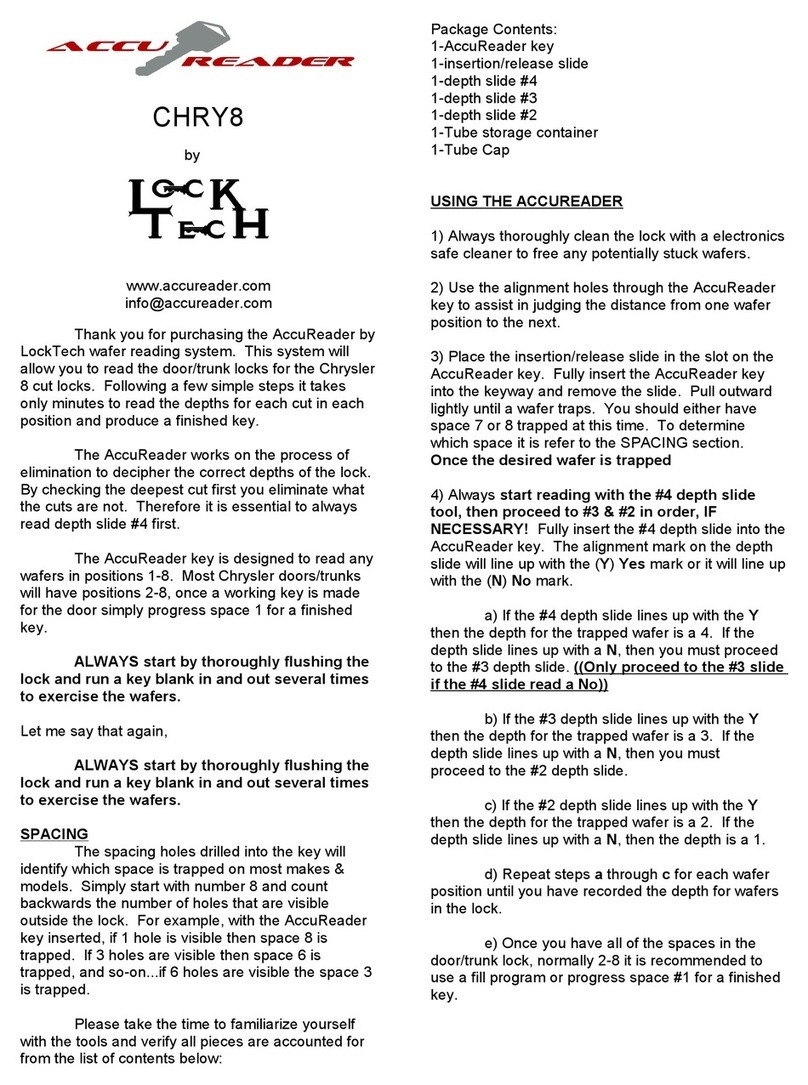
LockTech
LockTech ACCU READER CHRY8 quick start guide
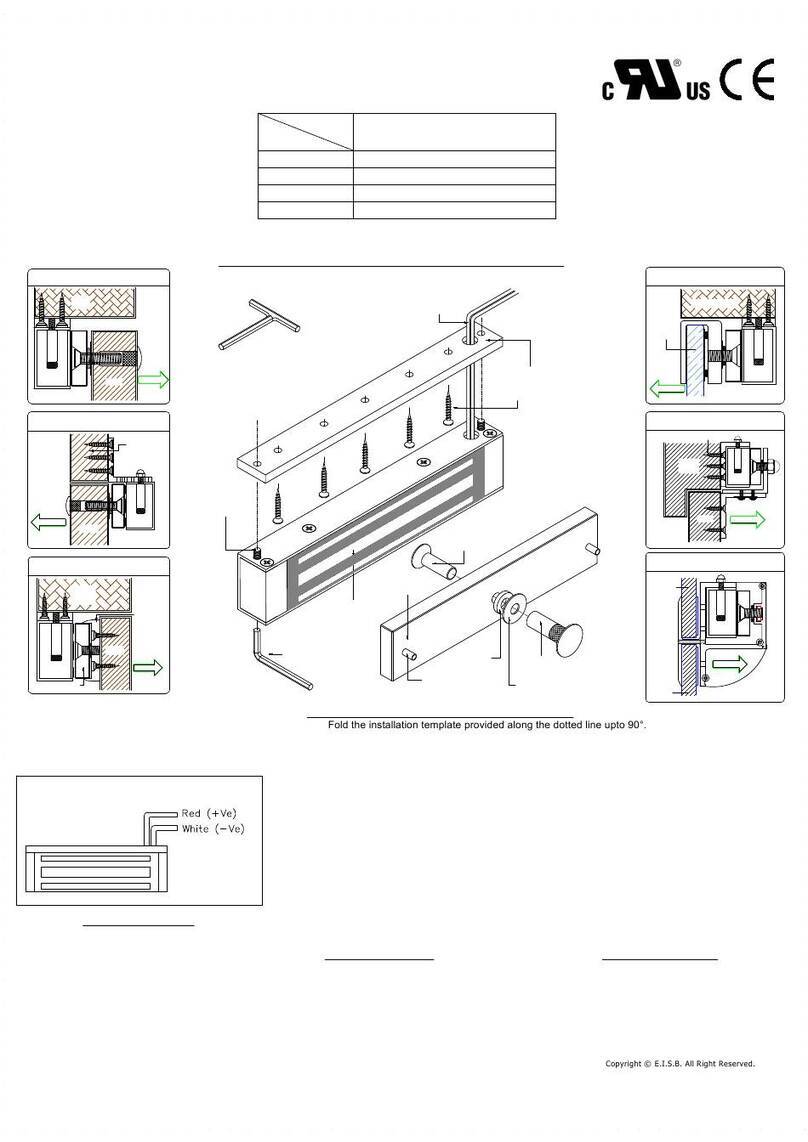
Ebelco
Ebelco 300-S Installation instruction guide

Rockwell
Rockwell 461US10B installation instructions

Yale
Yale Real Living YRD220 Installation and programming instructions

Salto
Salto Neoxx G4 installation guide
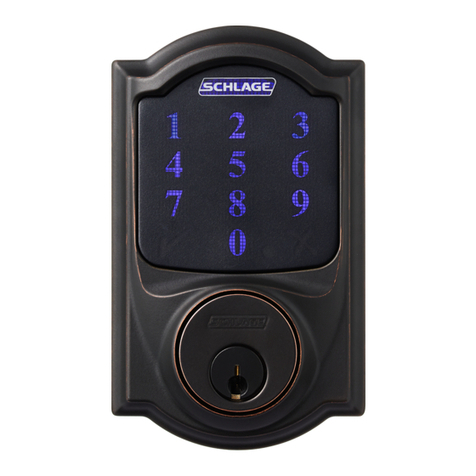
Schlage
Schlage Touchscreen Deadbolt with Alarm user guide
